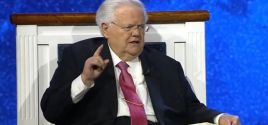Police Officers Can Sue Newspaper For Publishing Descriptive Info, Raising Serious First Amendment Issuesby Mike MasnickTechdirt Feb. 12, 2015 |
Popular 
Report: Blinken Sitting On Staff Recommendations to Sanction Israeli Military Units Linked to Killings or Rapes

America Last: House Bill Provides $26B for Israel, $61B for Ukraine and Zero to Secure U.S. Border

'Woke' Google Fires 28 Employees Who Protested Gaza Genocide

Bari Weiss' Free Speech Martyr Uri Berliner Wants FBI and Police to Spy on Pro-Palestine Activists

John Hagee Cheers Israel-Iran Battle as 'Gog and Magog War,' Will Lobby Congress Not to Deescalate
 We just recently wrote about a troubling case in the 9th Circuit in which a court tried to "balance" free speech rights against state publicity rights. Now, over in the 7th Circuit, there's a troubling ruling that seems to suggest a particular privacy law might similarly override the First Amendment. The writeup at the Columbia Journalism Review (link in the previous sentence) is a really great overview of the case, or you can read the ruling itself. In short, the Chicago Sun-Times published a series of reports investigating whether or not Chicago Police "manipulated" an investigation into a manslaughter case, involving a nephew of then Chicago mayor Richard M. Daley. That nephew, R.J. Vanecko, had apparently punched another man, David Koschman, leading Koschman to fall over and hit his head -- leading to a brain injury from which he died a few days later. The Sun-Times report argued that the police investigation was designed more to protect Vanecko, rather than bring him to justice. In exposing the questionable nature of the investigation, the Chicago Sun-Times highlighted the key "police lineup" that the CPD had put together, showing Vanecko and five police officers. No eyewitness picked out Vanecko, but the Sun-Times report argued that the police had chosen officers who strongly resembled Vanecko to make it difficult to pick out who really was involved. In order to make this point, reporters at the paper used a public records request to get the lineup photos, but then also got the physical information about the other officers in the photo via the state's motor vehicle records database, controlled by the Illinois Secretary of State. The point, obviously, was to show the physical resemblance to Vanecko. However, the officers in question sued the Sun-Times, arguing that publishing the information from the motor vehicle database, violated the Driver's Privacy Protection Act (DPPA) of 1994. That law bars the disclosure of "personal information" from the various Department of Motor Vehicles' records. It was originally passed after people had been using information in those databases to find and harass people they disagreed with politically. The Sun-Times argued, reasonably, that the First Amendment should protect its right to publish this information. However, both the lower court and the 7th Circuit appeals court have now both disagreed. The appeals court starts out by first noting that the information that was published -- the police officers' "approximate date of birth, height, weight, hair color, and eye color" are "personal information" as defined by the DPPA. That seems ridiculous enough already, given that those aren't exactly things that are private information for the most part. From there we get to the First Amendment analysis. First, the court says that there's nothing unconstitutional about the DPPA's prohibition on obtaining the information, since that doesn't involve any expression. The Sun-Times argued that even so, the purpose here was to stifle reporting by denying the press access to such information. It pointed to the recent ACLU case we covered, where the court said a law banning the recording of police violated the First Amendment, but the court doesn't buy it: However, ACLU is distinguishable on several grounds. While the Illinois eavesdropping statute's effect on First Amendment interests was "far from incidental" because it banned "all audio recording of any oral communication,"..., the same is not true of the DPPA's prohibition on the acquisition of personal information from a single, isolated source. It can hardly be said that this targeted restriction renders Sun-Times's right to publish the truthful information at issue here--much of which can be gathered from physical observation of the Officers or from other lawful sources (including, of course, a state FOIA request)--"largely ineffective." Further, in forbidding only the act of peering into an individual's personal government records, the DPPA protects privacy concerns not present in ACLU. If a member of the press observed one of the Officers in public--for example, during a traffic stop--he could publish any information gleaned from that interaction without offending the DPPA. By contrast, the Illinois eavesdropping statute operated as a total ban on recording police officers' activities, even when they were "performing their duties in public places and speaking at a volume audible to bystanders."Now, how about the restriction on disclosing the information -- which seems to fall even more squarely into the First Amendment arena? Again, the court doesn't buy it. It points out that while it would be protected in publishing the information if someone else got it and gave it to the Sun-Times, that doesn't apply if the Sun-Times itself broke the law in getting the information: The Supreme Court has established that "if a newspaper lawfully obtains truthful information about a matter of public significance then state officials may not constitutionally punish publication of the information, absent a need to further a state interest of the highest order." .... Sun-Times, however, cites no authority for the proposition that an entity that acquires information by breaking the law enjoys a First Amendment right to disseminate that information. Instead, all of the many cases on which Sun-Times relies involve scenarios where the press's initial acquisition of sensitive information was lawful.The court then has to do some rather fancy tap dancing to get around some of its previous rulings that said similar activity was protected free speech, by arguing that the "intent" matters. Sun-Times fares no better in its invocation of precedent from this circuit. Sun-Times points to our opinion in Thomas v. Pearl, 998 F.2d 447, 449 (7th Cir. 1993), in which a college basketball coach secretly taped conversations with a player about illegal perks offered by a rival university, as an example of what Sun-Times terms "theoretically unlawful news-gathering techniques inherent to successful journalism." Yet in Thomas, we determined that the coach lacked the requisite intent to be found in violation of federal wiretapping laws, id. at 452--53, and thus had not unlawfully obtained the in-formation at issue. Sun-Times also cites Desnick v. American Broadcasting Cos., 44 F.3d 1345, 1355 (7th Cir. 1995), for the proposition that the First Amendment protects a broadcaster's "surreptitious, confrontational, unscrupulous and ungentlemanly" investigatory tactics. But Desnick's ruling applies only insofar as "no established rights are invaded in the process." Id. Here, of course, Sun-Times's acquisition of the Officers' personal information invaded their established rights under the DPPA. This is a crucial distinction. Although Sun-Times claims that, in acquiring and disclosing truthful information, it engaged only in "perfectly routine, traditional journalism," it cannot escape the fact that it acquired that truthful information unlawfully.The thing that I don't get is why it's the Sun-Times that is being seen as the one who broke the DPPA here. It seems more like it was the Secretary of State, who gave the Sun-Times the information which it controlled in the first place. But the Court seems blind to that concept: We would face an analogous scenario if a third party had obtained personal information in violation of the DPPA and transmitted that information to Sun-Times, who subsequently published it. But that is not our case. Here, there is no intervening illegal actor: Sun-Times itself unlawfully sought and acquired the Officers' personal information from the Secretary of State, and proceeded to publish it. Where the acquirer and publisher are one and the same, a prohibition on the publication of sensitive information operates as an effective deterrent against the initial unlawful acquisition of that same information. Such acquisition carries little benefit independent of the right to disseminate that information to a broader audience. We therefore conclude that the government's deterrence interest is both important and likely to be advanced by the DPPA's ban on Sun-Times's disclosure of the Officers' per-sonal information.But that doesn't make much sense. Asking the Secretary of State for the information seems like a perfectly reasonable journalistic tactic in investigating a story. The court then goes into even more troubling waters, as the judges basically decide that the information here isn't that important anyway, and that also undermines the First Amendment claims. It notes that in other cases, courts have found that "privacy concerns give way when balanced against the interest in publishing matters of public importance." Again, we're back to this idea that there's some sort of mythical "balancing act" between the First Amendment and privacy rights. And, when the court puts these two things on the scales in this case, it thinks the balance goes to privacy, rather than the First Amendment. Why? Because it finds that the "personal information" about the officers really isn't that important to the story. While Sun-Times provided details of the Officers' physical traits to highlight the resemblance between the "fillers" and Vanecko, most of the article's editorial force was achieved through publication of the lineup photographs that Sun-Times obtained through its FOIA request--the value added by the inclusion of the Officers' personal information was negligible. Each Officer's height is evident from the lineup photographs, while their weights and ages are relevant only to the extent that they increase the Officers' resemblance to Vanecko--a resemblance that the photographs independently convey. And, although identifying the Officers' hair and eye colors may add some detail to the published black-and-white photographs, their personal information is largely redundant of what the public could easily observe from the photographs themselves. Therefore, Sun-Times's publication of the Officers' personal details both intruded on their privacy and threatened their safety, while doing little to advance Sun-Times's reporting on a story of public concern.This seems immensely troubling for a variety of reasons, not the least of which is that it puts the court system into the editing business, deciding which facts are actually relevant to the story, and which are somehow unnecessary. The court notes that it's possible a case "involving less privacy concerns or information of greater public significance" would come up with a different result, but that's also ridiculous. First of all, how is someone's height and eye color such a great "privacy concern"? Second, this again seems like a pretty clear restriction on the freedom of the press. It's not something that you "balance." The First Amendment is pretty clear that Congress cannot pass a law abridging the freedom of the press. And yet here, the court seems to think that it's okay, as long as it's "balanced." Because of this, the police can now sue the paper for daring to reveal their eye color and whatnot. This seems like a terrible ruling for the First Amendment, and even while the court tries to limit it to the specific facts of this case, it seems likely that this particular ruling is now likely to be cited against reporters quite a lot. Dahlstrom v Sun-Times (PDF) |



